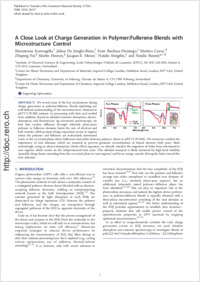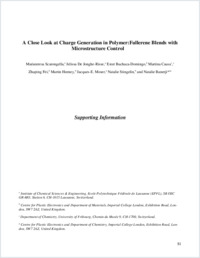A Close Look at Charge Generation in Polymer:Fullerene Blends with Microstructure Control
- Scarongella, Mariateresa Institute of Chemical Sciences & Engineering, EPFL, Lausanne, Switzerland
- Jonghe-Risse, Jelissa De Institute of Chemical Sciences & Engineering, EPFL, Lausanne, Switzerland
- Buchaca-Domingo, Ester Centre for Plastic Electronics and Department of Materials, Imperial College London, UK
- Causa, Martina Department of Chemistry, University of Fribourg, Switzerland
- Fei, Zhuping Centre for Plastic Electronics and Department of Chemistry, Imperial College London, UK
- Heeney, Martin Centre for Plastic Electronics and Department of Chemistry, Imperial College London, UK
- Moser, Jacques-E. Institute of Chemical Sciences & Engineering, EPFL, Lausanne, Switzerland
- Stingelin, Natalie Centre for Plastic Electronics and Department of Materials, Imperial College London, UK
- Banerji, Natalie Institute of Chemical Sciences & Engineering, EPFL, Lausanne, Switzerland
-
04.03.2015
Published in:
- Journal of the American Chemical Society. - 2015, vol. 137, no. 8, p. 2908–2918
English
We reveal some of the key mechanisms during charge generation in polymer:fullerene blends exploiting our well-defined understanding of the microstructures obtained in pBTTT:PCBM systems via processing with fatty acid methyl ester additives. Based on ultrafast transient absorption, electro-absorption, and fluorescence up-conversion spectroscopy, we find that exciton diffusion through relatively phase-pure polymer or fullerene domains limits the rate of electron and hole transfer, while prompt charge separation occurs in regions where the polymer and fullerene are molecularly intermixed (such as the co-crystal phase where fullerenes intercalate between polymer chains in pBTTT:PCBM). We moreover confirm the importance of neat domains, which are essential to prevent geminate recombination of bound electron–hole pairs. Most interestingly, using an electro-absorption (Stark effect) signature, we directly visualize the migration of holes from intermixed to neat regions, which occurs on the subpicosecond time scale. This ultrafast transport is likely sustained by high local mobility (possibly along chains extending from the co-crystal phase to neat regions) and by an energy cascade driving the holes toward the neat domains.
- Faculty
- Faculté des sciences et de médecine
- Department
- Département de Chimie
- Language
-
- English
- Classification
- Chemistry
- License
-
License undefined
- Identifiers
-
- RERO DOC 255740
- DOI 10.1021/ja510032x
- Persistent URL
- https://folia.unifr.ch/unifr/documents/304364
Other files
Statistics
Document views: 111
File downloads:
- pdf: 229
- Supplementary material: 233

